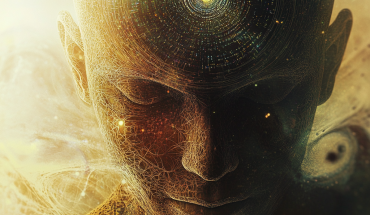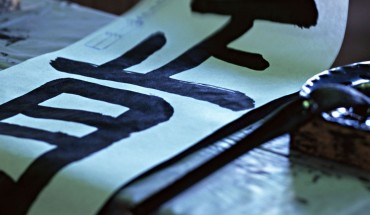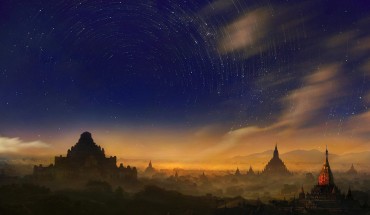This posting is going to be a bit cryptic…at least for most people. The chart which you see below is a compilation of many observations from the progress of Vipassana meditators on their journey from Samsara to personal experience of the various stages of insight knowledges.
The interesting part is, that in this chart i tried to visualize two components of that progress:
1. BLUE LINE: the time past by since one started practicing Vipassana (in a retreat environment, no breaks accounted for) with regard to one’s progress – this blue graph is logarithmic. Initial progress is quick, but will slow down eventually. By the time the meditator reaches Sankharupekkha it seems like he reached a “pinnacle”. Strong equanimity, very quick & clear noting and the “valley of sorrow” lies behind him. Lots of time can go by and many meditators are stuck here for a considerable time.
It is also interesting to see, that somehow the speed of noting sense objects seems to follow this logarithmic path. Probably they go hand in hand, as a considerable time spent in clear & fast noting has to build up momentum to “break through” the mirror/mirage of consciousness.
Especially the first three knowledges seem to be the stepping stones in building up the speed in noting…initially only the middle (the sense object itself) is noted, then the beginning (that is easier for tanha/greed, to see the arising of the world one lives in) and finally also the breaking up of sense objects. The speed/clarity of noting seems to closely correspond with the first three insight knowledges and the insights they bring with them…This culminates in the first huge breakthrough, the clear vision of rise & fall of all sense objects, very often going hand in hand with a powerful personal experience.
After 4., udayabbaya, comes the “valley of sorrow”, initialized by the insight knowledge of 5. bhanga which means “breaking”. The speed of noting and the clarity in seeing rise and fall makes the mind shift more and more towards the experience/observation of the destruction of all sense objects (sights, sounds, feelings…even thoughts! – {six sense in Buddha’s teachings, but if you didn’t know that this text won’t make any sense to you anyway, i guess :-)}. Seeing this never-before seen destruction of one’s entire world, moment for moment, over hours and days, will trigger a lot of not very pleasant experiences. Many meditators will drop it here and stop their Vipassana meditation. Those who continue sometimes cannot even explain what almost made them quit. Lots of things going on “subconsciously”/better: “karma forces working”.
The meditator is starting to “throw up” Samsara.
If he continues successfully through this “valley of sorrow” he is propelled by 9. Muncitu-Kamyata, the “desire to get out” and feels an upward surge in motivation, powers, stamina to go on with his meditation. Noting gets sharper, mind clearer. Sure, after accepting the obvious fact of his world crashing millisecond after millisecond he is gradually working on noting objects which are harder and harder to recognise. stuff which is so subtle and “self”-evident that only the speed and practise of noting peels off all layers of “my” and “mine” … minute after minute, hour after hour, day after day. Consistent pressure is the motto, as this effort has to go on for quite some time to reach a critical mass…
11. Sankharupekkha – see above…this is where many people get stuck. Sometimes for years! Important is the way you note. Not much clutter in terms of lots of labels…Simply razorsharp noting to not-identify with anything whatsoever & to keep up the pressure in seeing the whole world crash & reappear. Also nice to see how the mind cycles through 9-11 repeatedly.
Now the Visuddhimagga gives a set of nice similes, one of the Oxen who escaped (Zen “borrowed” this one 🙂 i really wonder whether they know from where it originated…Look them up @ XXI, 92. My guess is, with many of these very meditation-relevant practical things, that those similes are an echo from the early day of Buddhism, where the Arahant monks added some of their own personal experience .. which later got buried in the hands of scholars.
Be that as it may, the great simile i would like to mention here is this one: the land seeking bird
XXI, 65
“But if this [knowledge] sees nibbana, the state of peace, as peaceful, it rejects the occurance of all formations and enters only into nibbana. If it does not see nibbana as peaceful, it occurs again and again with formations as its object, like the sailor’s crow.
When traders board a ship, it seems, they take with them what is called a land-finding crow. When the ship gets blown off its course by gales and goes adrift with no land in sight, then they release the land-finding crow. it takes off from the mast-head, and after exploring all quarters, if it sees land, it flies straight in the direction of it; if not, it returns and alights on the mast-head.”
and it goes on
“…Now after discerning formations {everything which occurs} … as through sifting flour on the edge of a tray, as though carding cotton from which the seeds have picked out {isn’t that a great comparison to the technique of noting, where you go in, go along, but only short, labeling the object, and letting it go, moving to the next without following, attaching, identifying? Amazing!} and after abandoning terror and delight {possible positive hindrances in Vipassana which might occur as well! – usually breaking the letting go…}, and after becoming neutral in the investigation of formations, he still persists in the triple contemplation {dukkha, anicca, anatta. what about n’etam mama, nesohamasmi, netam me atta or other triplets used in Vipassana showing some kind of gradual modification to catch subtler and subtler objects} and it becomes a condition for the classification of noble persons into seven kinds {= enlightenment in scholarly terms}”
12. Anuloma…if you compare it with a srewdriver and a screw, trying to break through a wall: 9-11 seems like to push and apply one’s whole force to the screwdriver and 13. anuloma is like turning the screwdriver to get through the wall. Its a mini-repetition of all nyanas prior to it, seeing a relentless series of udayabaya-nyanas, mini-nibbidas, mini-sankharupekkhas until the point of the screw peeks through on the other side. I guess others can find better similies…but in a way this sounds like fractals….the structure within the structure…creating a very very strong counter-drag to release the mind, and pull name&form from consciousness thus making the world (ie. 6 senses, ie. bhava or existence) tumble/stop for one moment – with everlasting consequences.
Much more could be said on this, but one picture is worth a 1000 words, so i leave you at this point with the chart.
PS: Tradition names 16 vipassana nyanas – the last 3 of which comprise the moment of nibbana and a reflection which follows imediately. I thought we can discuss this maybe another time 😉
Links: There aren’t that many resources available on this topic. You might probably know these two excellent studies already:
- Ven. Sri Matara Ñāṇārāma Mahāthera : “The seven stages of purification” [en] [de] [book] esp. pp 82 ff. – 122
- Ven. Sri Matara Ñāṇārāma Mahāthera: “The Seven Contemplations” [de] [en], the entire book
- Ven. Aggapandita Mahasi Sayadaw: “Q&A on the Vipassana insight knowledges” [en] [de]
- Ven. Aggapandita Mahasi Sayadaw: “Practical Insight Meditation” [en]
- Ven. Aggapandita Ledi Sayadaw: “The Insight Manual” [en]
- In Pali: Abhidhammatthasangaha, p.44
- In Pali: Paramatthavinicchaya, 983 – 1020
- In Pali: Namarupapariccheda, 1641-3
- Search for “vipassanāñāṇ*” in the CST4 or online at tipitaka.org/search





Pingback: Zen like Vipassana :-) « Theravadin